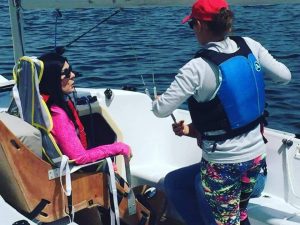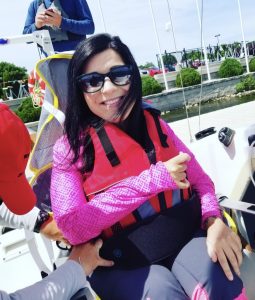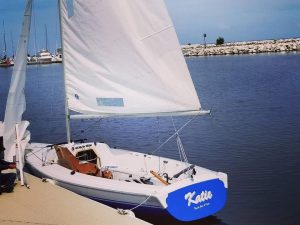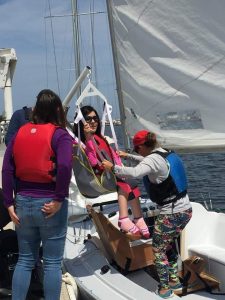Rolling Like the Waves: SMAdventures in Adaptive Sailing

Can you recall a day that shines brightly in your mind, as you were immersed in the beauty of nature and adventure all at once? Is there a time when your lungs inflated with a deep breath of peaceful fulfillment after the day unfolded, and even though the panoramic landscape of your life might be cluttered with unsightly hardships, this captivating day felt like a story written in the stars to lift you up?
For me, one such invigorating memory is the day I charted my course on an adaptive sailing adventure at Sailing Education Association of Sheboygan (SEAS) in Wisconsin.
SEAS involves a group of skilled and compassionate sailors who embark on each Wisconsin summertime by sharing their enthusiastic mission of making the waves accessible to people of all ability levels. Along the shores of Lake Michigan, the adaptive sailing program can be accessed through a $50 annual adaptive membership fee, which includes unlimited sailing excursions scheduled with an available instructor. When I learned of this awesome program through social media, I had to jump on board.
Sailing day arrived. On a late July dawn, the sun arose like a blazing empress with her fleet of billowing clouds, marching across the sky. She gently warmed the breeze underneath wings of dragonflies and seagulls alike, making for perfect sailing conditions. But the slow heat of the morning gave way to a sweltering, golden afternoon.
My friend Sarah and I were looking forward to the cool thrill of freshwater waves. We met with my cheerful instructor, with whom I’d already become well acquainted by discussing my SMA and physical limitations, so that she could best prepare for my needs. She excitedly pointed out the name of the adaptive sailboat: Katie. My eyes were nearly swallowed by the smile that flooded my cheeks.
We made our way along the harbor docks, and I parked my wheelchair next to a modified transfer lift that was affixed to the edge of a dock. I tend to feel scared when people transfer me out of my wheelchair. Guided by Sarah and SEAS staff, I was safely transferred with ease. The sailboat was equipped with a highly supportive chair that could be swiveled around, allowing for different views.
Once I was comfortable and secure, my instructor attached electronic buttons within close range of my hands. The large buttons moved the sails in different directions, allowing me to steer our boat on the open water. After a brief sailing lesson, the lake winds swept us away, and we set sail together. As the boat turned away from the dock, I stared back at my wheelchair, Violet. I felt a pang of endearing attachment to it. I was now steering a massively larger vessel, and it felt strange to be on a new adventure without Violet as my chariot.
The sentimental bubble abruptly burst when I noticed the blatant pile of crumbs from my breakfast croissant hanging out on my vacant wheelchair seat, right between where my thighs would rest. I giggled to myself and sensed my face flushing in a shade of embarrassment.
Out on the water, I felt free and proud of myself — not only for sailing, but also for keeping the “you’re gonna need a bigger boat” outbursts to a minimum.
Last year, a lady whom I’d only known for a few moments said to me, “Don’t ever let anyone tell you that you can’t do something.” We’d been chatting about accessible recreation, and at the time, I thought they were merely the graceful parting words of an encounter with a kind stranger. Since then, I’ve interpreted her words in a meaningful way.
Sailing and SMA wouldn’t seemingly go hand in hand. I could sit on shore admiring a sailboat. A narrow-minded passerby wandering the docks might stop and say to me, “Bummer, you’ll never get on that boat.”
And maybe they’re right, but the boat is irrelevant. What matters is the attitude of the people surrounding me, and whether I choose to follow their perspective or not. If I let the light in, then I cast away the negativity. If someone tells me I’ll never get on that boat, I’ll wish them well and send them on their way — they aren’t a part of my tribe in life, nor are they meant to travel this journey with me.
Instead, I’ll wait for the people who will sit beside me. “Jaws” jokes will abound. We’ll ponder solutions and stare at that boat until the sun falls beneath the horizon. When the vista transforms underneath the moonlight, perhaps the pathway to an accessible boat will be illuminated. If not, we still enjoyed a beautiful sunset together.
That’s what uplifting people do: They let a little light in and use their heart to enliven others. They build a more accessible world.
***
Note: SMA News Today is strictly a news and information website about the disease. It does not provide medical advice, diagnosis, or treatment. This content is not intended to be a substitute for professional medical advice, diagnosis, or treatment. Always seek the advice of your physician or other qualified health provider with any questions you may have regarding a medical condition. Never disregard professional medical advice or delay in seeking it because of something you have read on this website. The opinions expressed in this column are not those of SMA News Today, or its parent company, Bionews Services, and are intended to spark discussion about issues pertaining to spinal muscular atrophy.












Leave a comment
Fill in the required fields to post. Your email address will not be published.